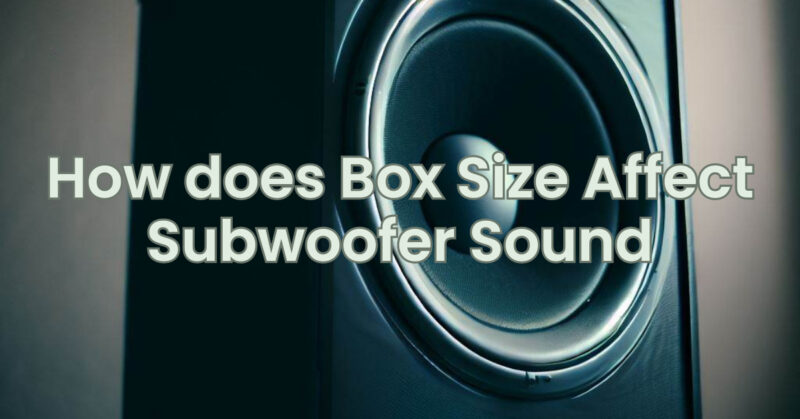When it comes to subwoofers, the size of the enclosure plays a crucial role in determining the overall sound quality and performance. The box size directly affects the way a subwoofer reproduces low-frequency sound waves. In this article, we will explore how box size affects subwoofer sound and discuss the implications it has on bass response, efficiency, and overall audio performance.
- Understanding Subwoofer Enclosures: Subwoofer enclosures come in different types, such as sealed, ported, bandpass, and more. Each type has its own characteristics, but the size of the enclosure is a critical factor across all designs. The size of the box impacts how the subwoofer driver interacts with the air inside the enclosure, influencing its ability to produce accurate and impactful bass.
- Box Size and Bass Response: a. Sealed Enclosures:
- Smaller Box Size: A smaller sealed enclosure typically results in tighter and more controlled bass response. The trapped air inside acts as a spring, allowing the subwoofer to move with precision and accuracy, delivering a punchy and well-defined bass.
- Larger Box Size: Increasing the size of a sealed enclosure can lead to a decrease in low-frequency extension and overall efficiency. The subwoofer may struggle to reproduce deep bass notes with the same impact and accuracy.
b. Ported Enclosures:
- Smaller Box Size: A smaller ported enclosure can result in increased low-frequency output, as the ported design allows for more efficient air movement. The subwoofer may produce louder and more pronounced bass, especially in the tuned frequency range.
- Larger Box Size: Enlarging the ported enclosure beyond the optimal size can lead to a loss of control and cause the bass to sound boomy or loose. It can also result in a reduction of overall output and efficiency.
- Efficiency and Power Handling: The size of the enclosure affects the efficiency and power handling capabilities of the subwoofer system. An appropriately sized enclosure ensures the subwoofer receives the power it needs to operate optimally without straining the amplifier. A mismatched box size can lead to reduced efficiency, power compression, and potentially damage the subwoofer or amplifier if driven beyond their limits.
- Frequency Response and Room Acoustics: Box size also interacts with room acoustics. The placement of the subwoofer and the dimensions of the listening space can create standing waves and resonances that affect the overall frequency response. Experimenting with different box sizes and room placements can help optimize bass response and minimize room-related issues.
- Manufacturer Recommendations and Specifications: It is important to consult the manufacturer’s recommendations and specifications for the subwoofer you are using. Manufacturers often provide guidelines on the ideal box size and design parameters for optimal performance. Adhering to these recommendations ensures that the subwoofer operates within its intended parameters, delivering the best possible sound quality.
The size of the subwoofer box significantly influences the sound quality, bass response, efficiency, and power handling capabilities of a subwoofer system. Whether it’s a sealed or ported enclosure, selecting the appropriate box size based on manufacturer recommendations and design principles is essential. A well-matched box size ensures accurate and impactful bass reproduction, allowing you to enjoy a rich and immersive audio experience.


